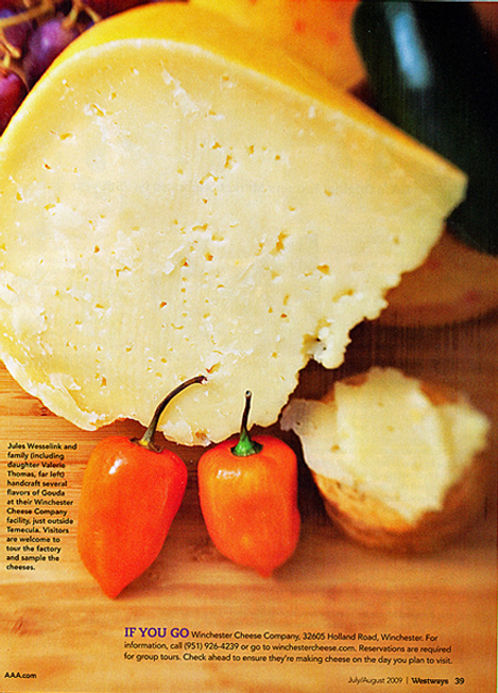

Winchester Cheese Company:
Making Artisan Cheese by Hand,
One Wheel at a Time
Thanks to the popularity of gourmet cooking shows and magazines, American palates have become more sophisticated than ever. As a result, artisan cheeses are now one of the hottest food trends in the country. Culinary enthusiasts attend cheese tastings, festivals, seminars, and competitions, both here and abroad.
So, exactly what is artisan cheese? As the word “artisan” implies, making these quality cheeses is an art. Handcrafted and produced in small quantities, artisan cheesemakers follow traditional methods and recipes that have been used for centuries. The result of the labor-intensive process is the most delectable cheese you’ll ever taste.
“Artisan cheese is made from raw milk. It’s 100% natural,” explained Jules Wesselink, founder of Winchester Cheese Company, a family-owned operation near Temecula. “It’s aged a minimum of 60 days and has a smoother texture than factory-produced cheese.”
Born in Holland, Jules Wesselink grew up working at his parents’ dairy farm. He moved to Southern California in the 1950s, where he opened a dairy in Artesia. As urban sprawl pushed dairy farmers into more remote regions, the Wesselink family eventually settled in a mountain-rimmed valley situated in Winchester, about two hours southeast of Los Angeles.
After a visit to Holland in 1995, Jules decided to try his hand at making Dutch cheese. A year later, he was producing Boere Kaas farmstead [farm made] Gouda, using milk from his own cows. Operating on a shoe-string in the early years of cheesemaking, Jules purchased a refrigerated trailer and converted it into an aging room. Additional trailers have been attached, creating offices, several aging rooms, a small gift shop and tasting area, a tour center, and the processing rooms.
The business has remained a family affair, though Jules is now retired. His daughter, Valerie Thomas, and her husband, David, run the operation and do most of the cheesemaking. Bending over the vat of white liquid while cutting the curds, Valerie explained, “It takes a full day to produce about 53 wheels of Gouda. The mixture is cut, strained, and molded by hand. It takes patience, experience, and a little magic to make the perfect cheese. Even then, no two batches ever turn out exactly the same.”
The Wesselinks sold their herd of Holsteins in 2001 and began using milk from their neighbor’s cows. Without the dairy, they could focus on making and selling cheese. And their efforts have paid off. Winchester’s Goudas have received numerous awards in competitions around the world. Not only can you find the Winchester brand at farmers’ markets and cheese specialty shops, their Goudas are used at upscale restaurants and wineries throughout the southland.
Visitors can tour the facility and sample the eight-plus flavors of Gouda. One of the most popular is a non-traditional recipe with a California twist: Jalapeño Gouda, a mildly spiced cheese that even the most delicate palate can handle. Jules Wesselink’s new favorite is the Cumin Gouda. He recommends putting it on pita bread and frying it in olive oil. “It’s absolutely delicious,” he said. Hungry yet?

